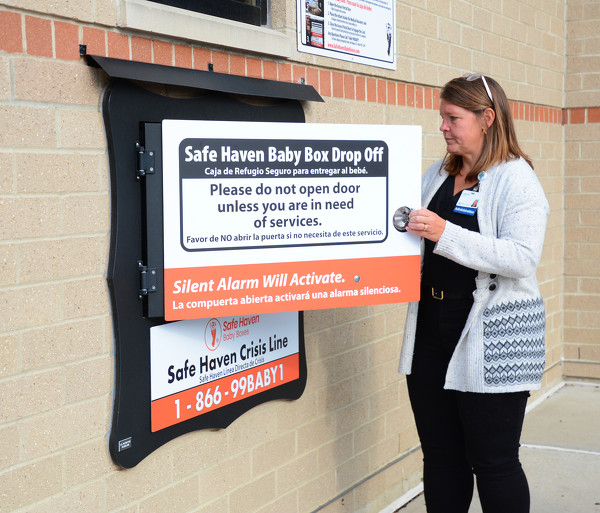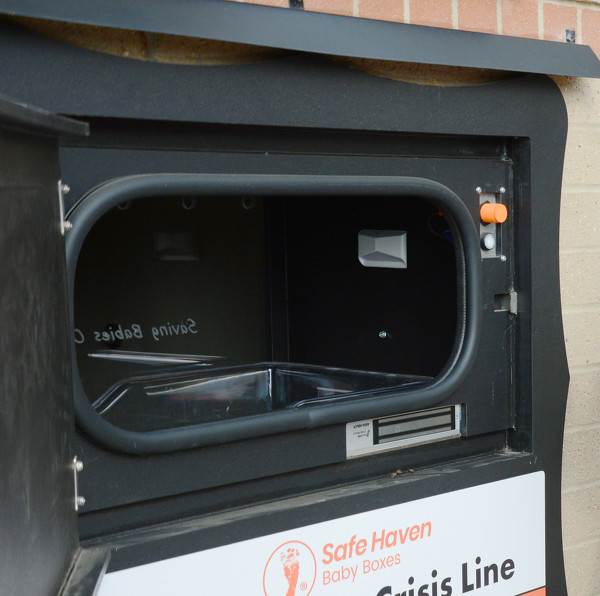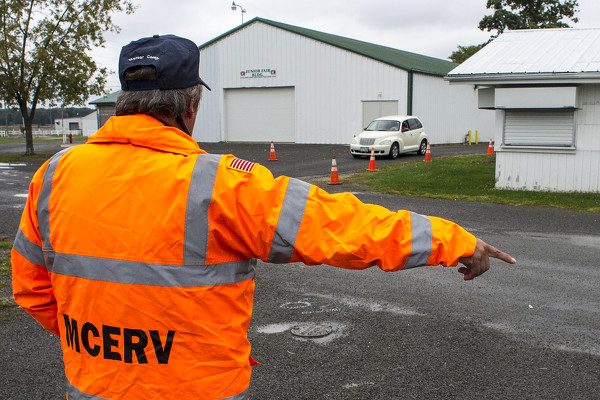Thursday, November 3rd, 2022
Baby Box is a Crisis Option
Moms can surrender baby
By Erin Gardner

Photo by Leslie Gartrell/The Daily Standard
Beth Keehn, director of government and community affairs at Mercy Health - St. Rita's Medical Center in Lima, opens a newly installed Safe Haven Baby Box. The box is a safety device under state law that legally permits a mother in crisis to safely, securely and anonymously surrender her baby if she is unable to care for her newborn.
LIMA - Embedded within the southwest corner of the Mercy Health - St. Rita's Medical Center's emergency department is a temperature-controlled black box, specifically a Safe Haven Baby Box.
The box is a safety device provided for under Ohio's Safe Haven Law and legally permits a mother in crisis to safely, securely and anonymously surrender her baby if she is unable to care for the newborn, according to Safe Haven Baby Boxes' website.
The box has an exterior door that automatically locks when a newborn is placed inside. An interior door allows a medical staff member to secure the surrendered newborn from within the designated building within seconds.
"First, our community has a whole lot of resources for mothers who are expecting or are pregnant and for after pregnancy. This is a last resort option," said Beth Keehn, director of government and community affairs at the hospital.
Lima's location is the state's seventh Safe Haven Baby Box and the 125th location nationally, according to a news release from Mercy Health. The box is climate controlled and features a silent alarm that notifies first responders of a surrender, allowing personnel to respond within five minutes to perform a medical evaluation.
No child has been surrendered at the hospital since the Safe Haven Law took effect in 2001, hospital officials said.
Because the process is designed to be anonymous, there are no cameras on the box. However, the box is heavily monitored, said campus police chief Gene Smith.
When a mother places her newborn in the bassinet within the box, silent alarms sound to alert police officials and emergency department staff.
Once a parent opens and closes the box, the door locks and can't be opened again, Keehn said.
"(The baby) will go to our special care nursery, which will essentially care for the infants until there's placement by children services," she said. "They will figure out if there's an adopted family interested (or if) there is a foster home safe to place."
Although the box is quite new, Ohio has had a safe haven law for some time. Under the law, parents can surrender their child within 30 days of birth and do it anonymously as long there are no obvious signs of abuse, Smith said.

Photo by Leslie Gartrell/The Daily Standard
The baby box is temperature controlled.
"Anonymity is more difficult if you have to look somebody in the face and surrender a baby," he said. "It's a difficult decision regardless, but then to look somebody in the face and do it. I think the box is an answer to that anonymity piece, yet maintains the safety. Obviously, I think we'd all be happier if the mom and baby had the resources to stay together, but that's not always the case. The law allows for it; this is just a mechanism."
Smith maintains the hospital was a safe haven long before it had the box because of state law.
Under the law, a parent can surrender their infant to a law enforcement agency, a hospital worker or an emergency medical services organization or worker. The law also stipulates that after taking possession of the newborn, police or medical professionals make sure the child doesn't need medical attention, notify children services, and if possible, make medical information forms and resources available to the parent.
If a parent voluntarily drops off their child, they will not be criminally prosecuted, according to the law.
If either parent changes their mind and wants the newborn back, they should go to the county's children services agency where they left the child. They will be asked to complete a DNA test, which may be a cost, to prove maternity or paternity, according to the Ohio Department of Job and Family Services.
Keehn said Sarah Bassitt, a nurse earning her master's degree, worked with the hospital to come up with a safe haven baby policy for parents and hospital personnel.
Bassitt conducted research that indicated there were trends among populations who were most at risk for abandoning their infants, and identified a community need in Lima, per the release. More than 24% of the population live under the poverty line in Lima, and many abandoned infants either were premature or had medical abnormalities.
The entire process from research to installation took a year, Keehn said. She did not have a cost estimate. Training included box installation, box training and learning new policies.
According to Child Welfare Information Gateway, a service through the U.S. Department of Health and Human Services, to qualify as a baby box, it must be physically located inside a safe haven site, located in an area that is conspicuous and visible to employees, allow anonymity notify a centralized location in the facility within 30 seconds of a child being placed in the 911 and trigger a 911 call if the staff at the facility do not respond within a reasonable time frame.
Keehn emphasized the box as a last resort to mothers who truly feel helpless.
"Honestly, this is one of those things you do and hope you never do (have a child surrendered)," she said. "Our hope is that women have found the resources they need previous to this. We also don't want to assume that everyone's life is perfect all the time. It's just another option."






